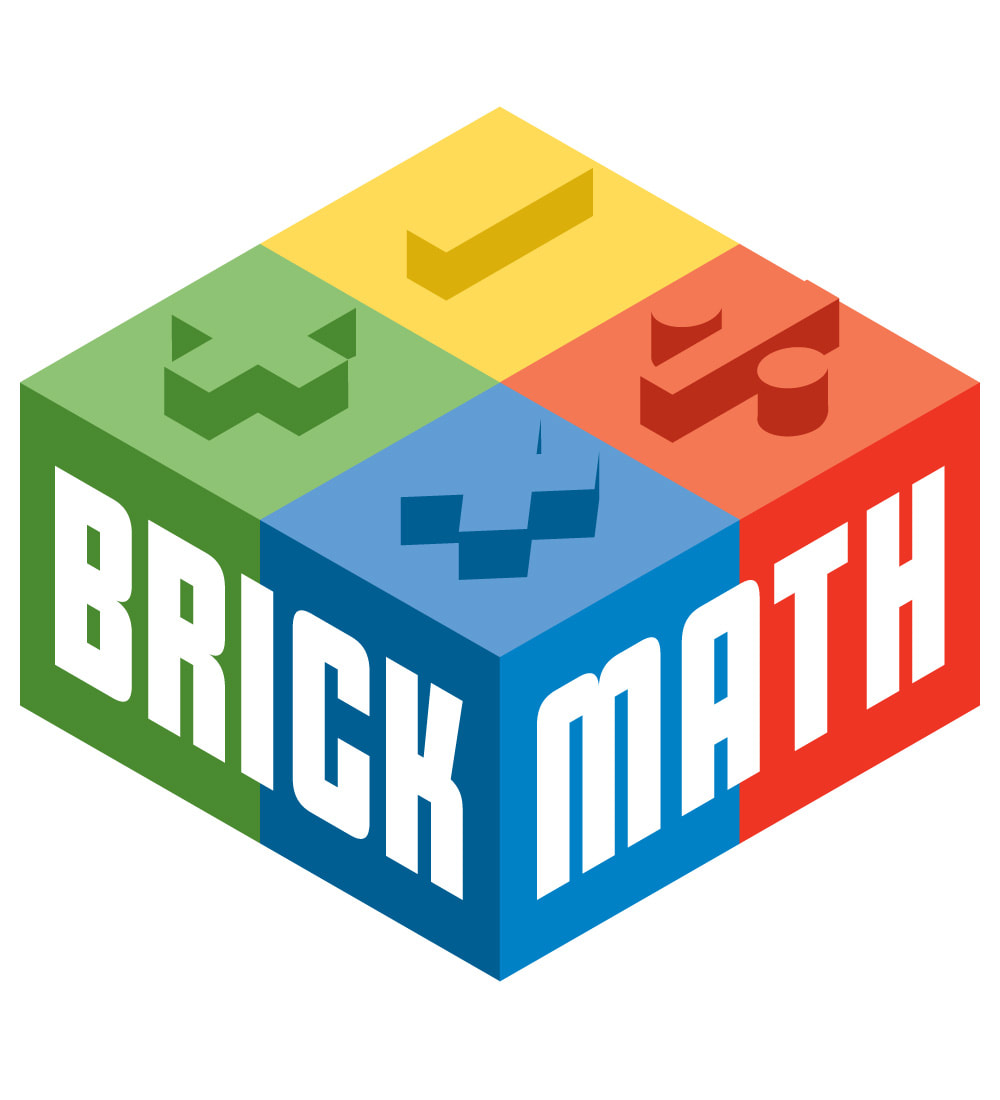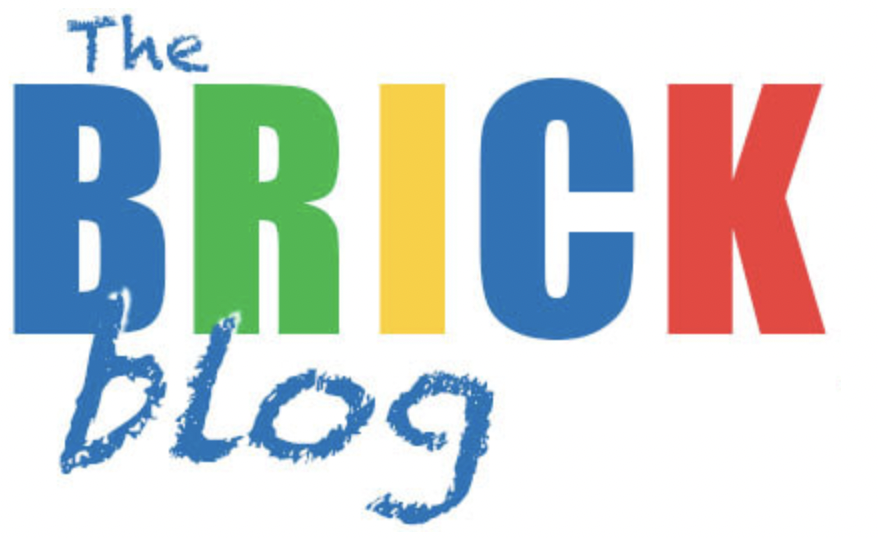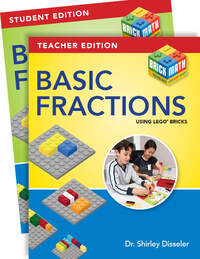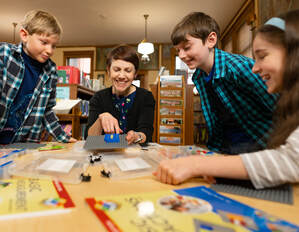 The Brick Math FREE Lesson of the Month for September 2023 is about Mixed Numbers and is taken from Basic Fractions Using LEGO® Bricks. The concept of a mixed number (a whole number and a fractional part) can be difficult for students to grasp, but modeling with bricks makes it so easy to learn. To get the September 2023 Brick Math Lesson of the Month, "Mixed Numbers," plus a new lesson each month, click here. Each Lesson of the Month includes the Teacher Lesson Guide as well as the Student Workbook Pages that correspond to the lesson. 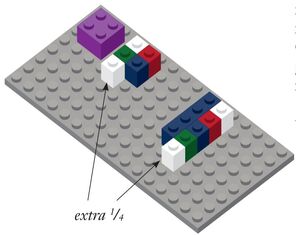 The lesson on mixed numbers first shows that a whole number can be divided into equal parts, and then shows how one more of that fractional part is added to the whole to make the mixed number. It's a very effective way to teach the concept of mixed numbers. It also shows the power of the Brick Math program, which makes math concepts visual and tactile so all students can learn them. 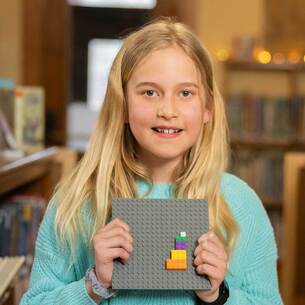 Brick Math is a K-8 math curriculum that uses LEGO® bricks to model 13 different math subjects: Counting, Addition, Subtraction, Multiplication, Division, Basic Fractions, Basic Measurement, Fraction Multiplication, Fraction Division, Advanced Measurement and Geometry, Decimals, Data and Statistics, and Pre-Algebra. Data and Statistics and Pre-Algebra expand the Brick Math curriculum to include grades 7 - 8. Brick Math works in many applications: for homeschooling, math intervention, enrichment, and as a whole-school program. Materials are simple and affordable. If you are a math teacher or a parent with a student at home who is learning K-8th grade math, check brickmath.com. The website includes videos for both teacher training and direct instruction of students. You can learn more about how Brick Math improves students' math test scores and hear what people who are using Brick Math have to say about the program.
0 Comments
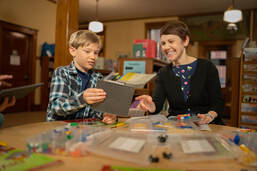 We think teachers are among the most generous people on earth. Not only do teachers give of their time and talents during the school day, they volunteer as coaches and club leaders after school and on weekends, just because they love kids and want to help. Most teachers we know also dip into their own pockets to buy items for their classrooms; in fact, research shows that teachers spend about $500 a year of their own money on supplies and curriculum that they know their students need and their school won’t buy. 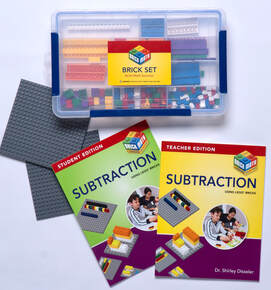 There’s a better way to find that extra money for your students: apply for a grant. There are many opportunities for funding curriculum. One of the most common questions we receive from teachers is, “How can I find the funds to purchase Brick Math for my classroom?” If you want to bring Brick Math to your classroom or school, we suggest several possible sources of funding that other teachers have used: • Title 1 Grants: These grants are available from the federal government based on school populations of low income students. We have seen a big uptick in schools ordering the Brick Math curriculum using Title 1 funds. Many schools tell us they plan to use Brick Math for intervention, to help struggling students learn basic K-8 math. Since Title 1 funds are intended to be supplementary to state and local funding, schools often use them to purchase additional curriculum to help students when more traditional methods haven’t worked. Brick Math is perfect for that purpose. • Teacher discretionary funds: In many schools, teachers receive a stipend to pay for classroom amenities and/or curriculum. Many teachers have purchased Brick Math with their discretionary funds to test the program in their own classrooms. • PTA funding – Often, Parent-Teacher groups offer money to fund new programs that teachers want their students to try. Check with your school’s PTA or PTO to see if they can help purchase Brick Math for your classroom or school. • Third-party grant programs: Generous non-profit foundations offer grants to fund curriculum like Brick Math. Many focus on STEM-related curriculum materials, and their awards range from a few hundred dollars to $50,000 or more. Look at smaller individual grants if you’re trying to fund Brick Math for your classroom, and check out larger grant programs if your school wants to bring in Brick Math on a larger scale. 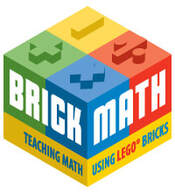 Thousands of schools around the world utilize Brick Math to help students “see” the math in the K-8 curriculum by modeling with LEGO®-compatible bricks. The 13 math subjects in Brick Math range from Counting to Pre-Algebra. Brick Math is a different approach to teaching math; the lessons utilize LEGO® bricks as manipulatives, and students model the math as they learn. For students whose learning style is hands-on, Brick Math is the research-based teaching solution that teachers and schools have been looking for. And what’s more fun than learning with LEGO® bricks?! The results of national testing are in. Math scores for 13-year-olds are down by 9 points since just before the start of the pandemic. For lower-performing students, declines are even larger: 12-14 points. The NAEP’s Long-Term Trend Assessment for Mathematics looked at the math performance of 13-year-olds across the US in 2020 and again in 2023. In every region of the country, and in every gender and racial group, students have declined in their math performance. According to Peggy Carr, commissioner of the National Center for Education Statistics, the pandemic accelerated the math decline, virtually wiping out the performance gains students made from the 1970s to 2020. 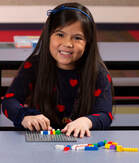 How do educators help students turn this around so kids can start building math success during the K-8th grade years? Brick Math is a solution that has been shown to increase test scores and improve students’ mathematical knowledge base. It’s a complete K-8 curriculum that teaches math by modeling math with LEGO® bricks. It’s fun to learn and easy to teach! The 13 math subjects in the Brick Math curriculum start with Counting and Cardinality for the earliest learners and go through Pre-Algebra (typically taught in late middle school). Students and teachers can start at any point in the curriculum. The materials are simple and very affordable:
In-person and online professional development is available for schools that want to fast-track the program into their curriculum. The 13 subjects in Brick Math include: Grades K - 2: Grades 3 - 4: Grades 5 - 6: Grades 7 - 8: Dr. Shirley Disseler, author of the Brick Math series, developed the concept after years of working with LEGO® Education. “I wanted to use LEGO® bricks to teach the basics of the math curriculum. It’s the perfect manipulative for teaching students the why behind the math to help them develop true mathematical understanding.” 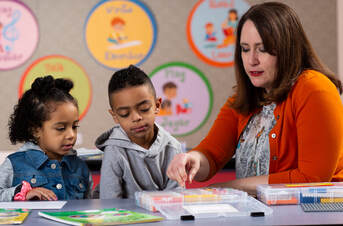 Students and teachers around the world are using Brick Math: as a whole-school curriculum, for students who are struggling to learn math, and for gifted education. The program aligns with state and national standards and is based on research from the most respected educators in the field. Homeschoolers are also using Brick Math with great success. For more information, check BrickMath.com or contact neil@brickmathseries.com.
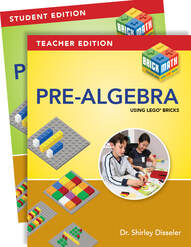 The Brick Math FREE Lesson of the Month for August 2023, "Absolute Value," is from our brand-new book, Pre-Algebra Using LEGO® Bricks. It's a great way to demonstrate the meaning of absolute value when you begin to introduce the concept. To get the August 2023 Brick Math Lesson of the Month, "Absolute Value," plus a new lesson each month, click here. Each Lesson of the Month includes the Teacher Lesson Guide as well as the Student Workbook pages that correspond to the lesson. 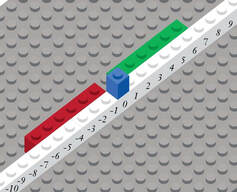 The lesson demonstrates absolute value using a number line built from bricks. Each stud represents a number, with a blue 1x1 brick in the center of the line to represent zero. Green bricks represent positive values on the number line, and red bricks represent negative values. The lesson teaches the vocabulary of absolute value, showing the "integer value" of numbers. Once students understand the concept of absolute value, they can move on to performing arithmetic operations with them. 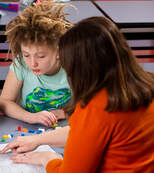 Brick Math is a K-8 math curriculum that uses LEGO® bricks to model 13 different math subjects: Counting, Addition, Subtraction, Multiplication, Division, Basic Fractions, Basic Measurement, Fraction Multiplication, Fraction Division, Advanced Measurement and Geometry, Decimals, Data and Statistics, and Pre-Algebra. Data and Statistics and Pre-Algebra expand the Brick Math curriculum to include grades 7 - 8. Brick Math works in many applications: for homeschooling, math intervention, enrichment, and as a whole-school program. Materials are simple and affordable. If you are a math teacher or a parent with a student at home who is learning K-8th grade math, check brickmath.com. The website includes videos for both teacher training and direct instruction of students. You can learn more about how Brick Math improves students' math test scores and hear what people who are using Brick Math have to say about the program. 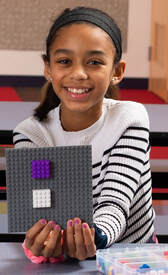 Brick Math is proud to announce our brand-new 7th - 8th grade content with two new subjects added to the curriculum: Pre-Algebra and Data and Statistics. As with all the Brick Math curriculum, the content is taught by modeling the math with LEGO® or LEGO®-compatible bricks, giving students a hands-on experience that helps them gain deep understanding of the mathematical concepts. Each subject has a Teacher Edition that guides the teacher through the step-by-step lessons as well as a Student Edition that is a workbook for students to draw their brick models and includes student assessments for every chapter. The Brick Math brick set works for these new subjects, too. 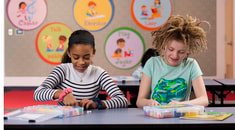 The new content extends Brick Math to a complete K - 8 curriculum solution for schools as well as for homeschooling. Brick Math is ideally suited for students who haven’t been able to learn the concepts through more traditional methods. 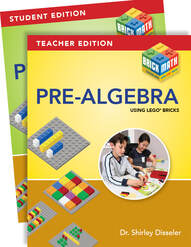 In Pre-Algebra, students are introduced to topics that help them prepare for high school math. These include integers, fractions, square roots, step equations, linear equations, and decimals. Students learn how to solve basic equations using variables. Modeling with bricks, students engage in problem-solving activities that expand their knowledge of: • absolute value and positive/negative numbers • exponents, including negative exponents and multiplicative inverse • rules of integers • algebraic expressions • equations and inequalities • slope 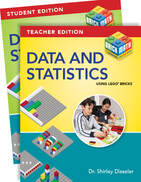 In Data and Statistics, students learn the basics of representing and interpreting data with line plots, bar graphs, histograms, and box plots. They learn how to measure central tendency through mean, median, mode, and range. Then students move on to learn about coordinates, line graphs, and scatter plots. Finally, they learn how to graph and calculate the slope of a line. The final chapter is an introduction to both theoretical and experimental probability. Modeling with bricks, students engage in problem-solving activities that expand their knowledge of: • visual models and graphs of data sets • measures of central tendency • coordinate grids • slope • theoretical and experimental probability Both books progress through these topics in modules, moving from more basic to more complex in each chapter. Most students learn these Pre-Algebra and Data and Statistics topics in grades 7 - 8. We have had so many requests to extend the Brick Math program through eighth grade, and it’s finally here! We’re excited to share the new Brick Math content with you. Brick Math is a K-8 math curriculum that uses LEGO® bricks to model 13 different math subjects:
Counting, Addition, Subtraction, Multiplication, Division, Basic Fractions, Basic Measurement, Fraction Multiplication, Fraction Division, Advanced Measurement and Geometry, Decimals, Data and Statistics, and Pre-Algebra. Brick Math works in many applications: for homeschooling, math intervention, enrichment, and as a whole-school program. Materials are simple and affordable. If you are a math teacher or a parent with a student at home who is learning K-8th grade math, check brickmath.com. The website includes videos for both teacher training and direct instruction of students. You can learn more about how Brick Math improves students' math test scores and hear what people who are using Brick Math have to say about the program. 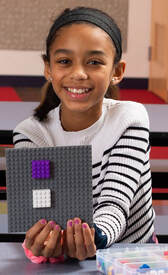 The July 2023 Brick Math Lesson of the Month comes from Multiplication Using LEGO® Bricks, one of the best-selling titles in the Brick Math Series. The lesson teaches students about arrays, and shows how to model multiplication with bricks that create arrays. It's a great way to reinforce multiplication while adding the new vocabulary of arrays and area. To get the July 2023 Brick Math Lesson of the Month, "Multiplication with Array Models," plus a new lesson each month, click here. Each Lesson of the Month includes the Teacher Lesson Guide as well as the Student Workbook pages that correspond to the lesson.  In this lesson, students learn about arrays and the importance of knowing the orientation of an array. Then they learn to build multiplication sentences based on the array's configuration. These exercises really help students understand the concepts behind one-digit multiplication. 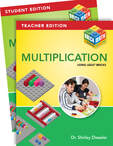 Bricks are the perfect tools to model arrays. Modeling with bricks helps students understand what an array is and how it relates to multiplication. The study of mathematics is a building process (pun intended!) that relies on students understanding foundational math before moving on to more complex ideas. 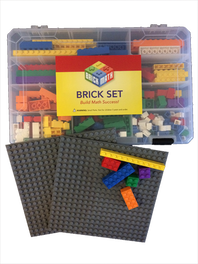 Brick Math is a K-6 math curriculum that uses LEGO® bricks to model 11 different math subjects: Counting, Addition, Subtraction, Multiplication, Division, Basic Fractions, Basic Measurement, Fraction Multiplication, Fraction Division, Advanced Measurement and Geometry, and Decimals. This year, the program will expand to include grades 6 - 8, with the additional subjects Data and Statistics, Pre-Algebra, and Ratios and Proportions. Brick Math works in many applications: for homeschooling, math intervention, enrichment, and as a whole-school program. Materials are simple and affordable. If you are a math teacher or a parent with a student at home who is learning K-8th grade math, check brickmath.com. The website includes videos for both teacher training and direct instruction of students. You can learn more about how Brick Math improves students' math test scores and hear what people who are using Brick Math have to say about the program.
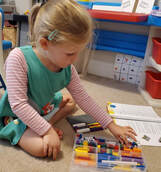 The June 2023 Brick Math Lesson of the Month shows how to teach early learners the very basics of understanding square numbers. It's part of the Counting and Cardinality Using LEGO® Bricks curriculum. To get the June 2023 Brick Math Lesson of the Month, "Square Number Concepts," plus a new lesson each month, click here. Each Lesson of the Month includes the Teacher Lesson Guide as well as the Student Workbook pages that correspond to the lesson. 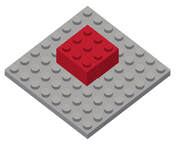 In the lesson, students build 2-stud, 4-stud, and 9-stud configurations with bricks. They are encouraged to see that 4-stud and 9-studs can be modeled in the shape of a square, and that there are 2 and 3 studs on each side of the square. In this way, the concept of square numbers is introduced, and will be returned to later when students learn multiplication. 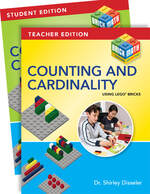 The importance of building skills in math over time can't be stressed enough. This lesson is a great example of how to start from the earliest years, using mathematical terminology to teach concepts young students can grasp. Incorporating bricks to make the lesson visual helps students build math knowledge that will last a lifetime. Brick Math is a K-6 math curriculum that uses LEGO® bricks to model 11 different math subjects: Counting, Addition, Subtraction, Multiplication, Division, Basic Fractions, Basic Measurement, Fraction Multiplication, Fraction Division, Advanced Measurement and Geometry, and Decimals. 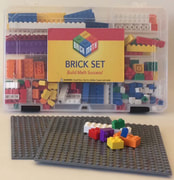 This year, the program will expand to include grades 6 - 8, with the additional subjects Data and Statistics, Pre-Algebra, and Ratios and Proportions. Brick Math works in many applications: for homeschooling, math intervention, enrichment, and as a whole-school program. Materials are simple and affordable. If you are a math teacher or a parent with a student at home who is learning K-8th grade math, check brickmath.com. The website includes videos for both teacher training and direct instruction of students. You can learn more about how Brick Math improves students' math test scores and hear what people who are using Brick Math have to say about the program. 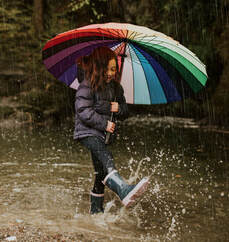 Image by rawpixel.com on Freepik Image by rawpixel.com on Freepik "April showers bring May flowers." April's Lesson of the Month on Decomposing Numbers in Addition brings May's Lesson of the Month on...Decomposing Numbers in Subtraction! To get the May 2023 Brick Math Lesson of the Month, "Decomposing Numbers / Place Value," plus a new lesson each month, click here. Each Lesson of the Month includes the Teacher Lesson Guide as well as the Student Workbook pages that correspond to the lesson. 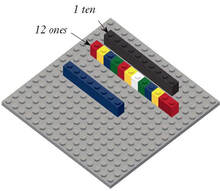 This lesson, from Brick Math's Subtraction Using LEGO® Bricks, models decomposing one ten into ten ones for the purpose of solving a subtraction problem. It also helps students understand the concept of place value, clearly showing bricks that represent both the tens and the ones places. It's a great way to explain what it actually means to subtract 8 from 22, which can be a difficult idea for some students to grasp when they start learning to subtract. 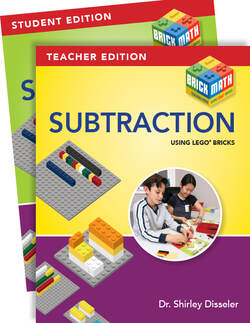 Brick Math is a K-6 math curriculum that uses LEGO® bricks to model 11 different math subjects: Counting, Addition, Subtraction, Multiplication, Division, Basic Fractions, Basic Measurement, Fraction Multiplication, Fraction Division, Advanced Measurement and Geometry, and Decimals. This year, the program will expand to include grades 6 - 8, with the additional subjects Data and Statistics, Pre-Algebra, and Ratios and Proportions. Brick Math works in many applications: for homeschooling, math intervention, enrichment, and as a whole-school program. Materials are simple and affordable. 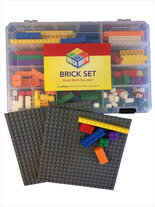 If you are a math teacher or a parent with a student at home who is learning K-8th grade math, check brickmath.com. The website includes videos for both teacher training and direct instruction of students. You can learn more about how Brick Math improves students' math test scores and hear what people who are using Brick Math have to say about the program. 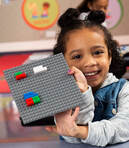 The Brick Math Free Lesson of the Month for April 2023 comes from the book Addition Using Lego® Bricks. It's a great way to show young learners the meaning of ones and tens, and how to transform 10 ones into 1 ten. To get the April 2023 Brick Math Lesson of the Month, "Decomposing Numbers," plus a new lesson each month, click here. 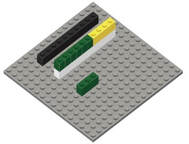 This concept is foundational to mathematics, and will appear again and again as students learn about place value throughout the elementary and middle school math curriculum. This simple method of showing how to decompose from ones to tens using LEGO® bricks will help every student fully grasp the concept. 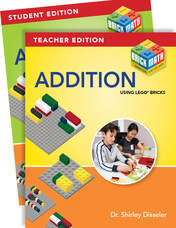 Brick Math is a K-6 math curriculum that uses LEGO® bricks to model 11 different math subjects: Counting, Addition, Subtraction, Multiplication, Division, Basic Fractions, Basic Measurement, Fraction Multiplication, Fraction Division, Advanced Measurement and Geometry, and Decimals. This year, the program will expand to include grades 6 - 8, with the additional subjects Data and Statistics, Pre-Algebra, and Ratios and Proportions. Brick Math works in many applications: for homeschooling, math intervention, enrichment, and as a whole-school program. Materials are simple and affordable. 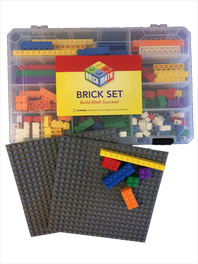 If you are a math teacher or a parent with a student at home who is learning K-8th grade math, check brickmath.com. The website includes videos for both teacher training and direct instruction of students. You can learn more about how Brick Math improves students' math test scores and hear what people who are using Brick Math have to say about the program. 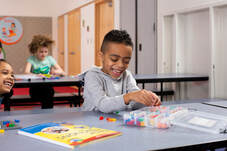 This is the time of year schools start planning for their summer programs. We’ve been busy lately, responding to school districts planning to use the Brick Math curriculum this summer. 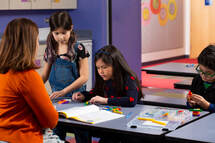 Brick Math is the perfect way to engage struggling students in math summer school. Naturally, students enjoy using the bricks as math manipulatives. But even more importantly, Brick Math is a modular program that targets specific math skills. Students learn using different methods than other math programs, and experience shows that they respond very positively to the hands-on program. 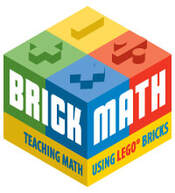 Brick Math offers free curricula of summer programs for each of the 11 subject areas for schools who choose Brick Math as their summer school curriculum. These programs can be easily adapted to your school’s schedule. To view a sample of Brick Math’s summer program, click here. The sample shows Day 1 of a 12-day summer program for Basic Fractions. 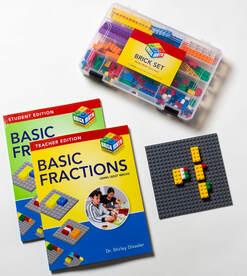 The 11 Brick Math topics include: Brick Math has been shown to increase students’ test scores significantly. Students gain a real understanding of the reasons why behind the math when they learn with Brick Math.
Please call 802-751-8002 or email us if you'd like to learn more about how to use Brick Math in your school's summer program. |
Categories
All
Archives
May 2024
|

